Experimental Study of the Convective Heat Transfer and Local Thermal Equilibrium in Ceramic Foam
Abstract
1. Introduction
2. Single-Blow Method
2.1. Physical Problem
2.2. Single-Blow Method
3. Experimental Apparatus and Procedure
3.1. Test Rig
3.2. Foam Sample
3.3. Experimental Procedure
- i.
- Install the sample, sensors. Check all the facilities of the test rig. Confirm all the experimental parameters, including the initial temperature , the airstream temperature and the superficial velocity.
- ii.
- Prepare the initial conditions. Hot air is obtained to heat the foam until it reaches at the steady state (T = 323 K), this is realized by switching valve A to B and adjusting the frequency of fan 1 as well as the power of heater 1. It can be considered that the foam has a uniform temperature when the temperature difference at the inlet and outlet is less than 0.2 K, and last for 10 min.
- iii.
- Conduct the transient experiment. After the sample reaching at the steady condition, the heater 1 and fan 1 are quickly turned off and the valve B is switch to A at the same time, the temperature changes of the fluid before and behind foam material are recorded by thermocouples. For each sample, the above experiment with different superficial air velocities is performed, where the superficial air velocities varied between 0.58 m/s–1.76 m/s.
4. Results and Discussion
4.1. Data Reduction
4.2. Local Thermal Equilibrium Phenomenon
4.3. Effect of the Sample Pore Structure
4.4. Effect of the Sample Thickness
4.5. Heat Transfer Correlation
5. Conclusions and Future Work
- (1)
- The local thermal equilibrium phenomenon within the porous media is firstly verified by experiment. One of the theoretical assumptions of the single-blow transient techniques, “the airstream and the entire sample are always under the local thermal nonequilibrium state during the experiment”, is not true. The reason is that there exists the local thermal equilibrium zone within the sample during the experiment.
- (2)
- The local thermal equilibrium phenomenon is prone to occur within the foam materials, because the value of volumetric heat transfer coefficient within the foam materials can be easily reach at 105 W/(m3·K), while the superficial velocity is about 1 m/s (this air velocity is very small in the common engineering applications). When the thickness is large or the surface velocity is low, the local thermal equilibrium phenomenon is particularly considerable.
- (3)
- The single-blow transient measuring technique can still be used to obtain the volumetric heat transfer coefficient, and regardless of the local thermal equilibrium phenomenon. However, the existence of local thermal equilibrium zone will significantly decrease the value of volumetric heat transfer coefficient.
- (4)
- A new correlation includes the foam material’s thickness, porosity, the gas superficial velocity and the gas’s properties, and is considered more applicable. This correlation was built on the base of 54 types of sample (six types of thickness, three types of porosity, and three types of PPI) and a wide range of superficial velocity. The correlation agrees well with the experimental data.
Author Contributions
Funding
Acknowledgments
Conflicts of Interest
Nomenclature
| A | Surface area [m2] |
| Specific surface area [m2 m−3] | |
| c | Constant |
| Thermal capacity [J kg−1 K−1] | |
| d | Cell diameter |
| Mean cell size [m] | |
| Pore diameter | |
| Strut diameter | |
| Convective heat transfer coefficient [W m−2 K−1] | |
| Volumetric heat transfer coefficient [W m−3 K−1] | |
| L | Sample thickness |
| Nusselt number based on | |
| P | Pressure [Pa] |
| q | Heat flux [W m−2] |
| Q | Total heat flux [W m−2] |
| Re | Reynolds number () |
| Temperature difference | |
| x | Coordinate along thickness direction |
| l | Dimensionless thickness |
| Velocity | |
| Greek symbols | |
| Thermal conductivity [W m−1 K−1] | |
| Porosity | |
| Dimensionless outlet air temperature | |
| Density [kg m−3] | |
| Dynamic viscosity [kg m−1 s−1] | |
| Residual error | |
| Subscripts | |
| Computational | |
| exp | Experimental |
| m | Equilibrium |
| eff | Effective |
| f | Fluid |
| s | Solid |
| t | Thickness |
| in | Inlet |
| out | Outlet |
| Volumetric | |
| 0 | Refers to t = 0 or Z = 0 |
References
- Zhao, C.Y. Review on Thermal Transport in High Porosity Cellular Metal Foams with Open Cells. Int. J. Heat Mass Transf. 2012, 55, 3618–3632. [Google Scholar] [CrossRef]
- Odabaee, M.; Hooman, K. Metal Foam Heat Exchangers for Heat Transfer Augmentation from a Tube Bank. Appl. Therm. Eng. 2012, 36, 456–463. [Google Scholar] [CrossRef]
- Feng, S.S. An Experimental and Numerical Study of Finned Metal Foam Heat Sinks under Impinging Air Jet Cooling. Int. J. Heat Mass Transf. 2014, 77, 1063–1074. [Google Scholar] [CrossRef]
- Behar, O.; Khellaf, A.; Mohammedi, K. A Review of Studies on Central Receiver Solar Thermal Power Plants. Renew. Sustain. Energy Rev. 2013, 23, 12–39. [Google Scholar] [CrossRef]
- Cao, Z.; Wei, B. α-Fe2O3/Single-Walled Carbon Nanotube Hybrid Films as High-Performance Anodes for Rechargeable Lithium-Ion Batteries. J. Power Sources 2013, 241, 330–340. [Google Scholar] [CrossRef]
- Chueh, W.C.; Falter, C.; Abbott, M.; Scipio, D.; Furler, P.; Haile, S.M.; Steinfeld, A. High-Flux Solar-Driven Thermochemical Dissociation of CO2 and H2O Using Nonstoichiometric Ceria. Science 2010, 330, 1797–1801. [Google Scholar] [CrossRef]
- Bouma, P.H.; De Goey, L.P.H. Premixed Combustion on Ceramic Foam Burners. Combust. Flame 1999, 119, 133–143. [Google Scholar] [CrossRef]
- Salas, K.I.; Waas, A.M. Convective Heat Transfer in Open Cell Metal Foams. J. Heat Transf. Trans. ASME 2007, 129, 1217–1229. [Google Scholar] [CrossRef]
- Wu, Z.; Caliot, C.; Flamant, G.; Wang, Z. Numerical Simulation of Convective Heat Transfer between Air Flow and Ceramic Foams to Optimise Volumetric Solar Air Receiver Performances. Int. J. Heat Mass Transf. 2011, 54, 1527–1537. [Google Scholar] [CrossRef]
- Kribus, A.; Gray, Y.; Grijnevich, M.; Mittelman, G.; Mey-Cloutier, S.; Caliot, C. The Promise and Challenge of Solar Volumetric Absorbers. Sol. Energy 2014, 110, 463–481. [Google Scholar] [CrossRef]
- Younis, L.B.; Viskanta, R. Experimental Determination of the Volumetric Heat Transfer Coefficient between Stream of Air and Ceramic Foam. Int. J. Heat Mass Transf. 1993, 36, 1425–1434. [Google Scholar] [CrossRef]
- Fu, X.; Viskanta, R.; Gore, J.P. Measurement and Correlation of Volumetric Heat Transfer Coefficients of Cellular Ceramics. Exp. Therm. Fluid Sci. 1998, 17, 285–293. [Google Scholar]
- Hwang, J.J. Measurement of Interstitial Convective Heat Transfer and Frictional Drag for Flow across Metal Foams. J. Heat Transf. 2002, 124, 120–129. [Google Scholar] [CrossRef]
- Kamiuto, K. Study of Dul’nev’s Model for the Thermal and Radiative Properties of Open-Cellular Porous Materials. JSME Int. J. Ser. B Fluids Therm. Eng. 1997, 40, 577–582. [Google Scholar] [CrossRef]
- Kamiuto, K.; Yee, S.S. Heat Transfer Correlations for Open-Cellular Porous Materials. Int. Commun. Heat Mass Transf. 2005, 32, 947–953. [Google Scholar] [CrossRef]
- Zhang, H.; Tan, J.; Zhang, L. Measurement of Volumetric Convective Heat Transfer Coefficient in Porous Aluminum. J. Chem. Ind. Eng. 2004, 55, 1710–1713. [Google Scholar]
- Hernández, Á.R.Á. Combined Flow and Heat Transfer Characterization of Open Cell Aluminum Foams. Master’s Thesis, University of Puerto Rico, San Juan, Puerto Rico, 2005. [Google Scholar]
- Zhang, W.; Li, N.; He, D. Inversion Analysis of Volumetric Heat Transfer Coefficient for Porous Aluminum. Chin. J. Mater. Res. 2007, 21, 20–24. [Google Scholar]
- Dietrich, B. Heat Transfer Coefficients for Solid Ceramic Sponges—Experimental Results and Correlation. Int. J. Heat Mass Transf. 2013, 61, 627–637. [Google Scholar] [CrossRef]
- Vijay, D.; Goetze, P.; Wulf, R.; Gross, U. Forced Convection through Open Cell Foams Based on Homogenization Approach: Steady State Analysis. Int. J. Therm. Sci. 2015, 98, 381–394. [Google Scholar] [CrossRef]
- Fend, T.; Hoffschmidt, B.; Pitz-Paal, R.; Reutter, O.; Rietbrock, P. Porous Materials as Open Volumetric Solar Receivers: Experimental Determination of Thermophysical and Heat Transfer Properties. Energy 2004, 29, 823–833. [Google Scholar] [CrossRef]
- Xia, X.-l.; Chen, X.; Sun, C.; Li, Z.-h.; Liu, B. Experiment on the Convective Heat Transfer from Airflow to Skeleton in Open-Cell Porous Foams. Int. J. Heat Mass Transf. 2017, 106, 83–90. [Google Scholar] [CrossRef]
- Kuwahara, F.; Shirota, M.; Nakayama, A. A Numerical Study of Interfacial Convective Heat Transfer Coefficient in Two-Energy Equation Model for Convection in Porous Media. Int. J. Heat Mass Transf. 2001, 44, 1153–1159. [Google Scholar] [CrossRef]
- Krishnan, S.; Murthy, J.Y.; Garimella, S.V. Direct Simulation of Transport in Open-Cell Metal Foams. Am. Soc. Mech. Eng. 2005, 128, 793–799. [Google Scholar]
- Kuwahara, F.; Yamane, T.; Nakayama, A. Large Eddy Simulation of Turbulent Flow in Porous Media. Int. Commun. Heat Mass Transf. 2006, 33, 411–418. [Google Scholar] [CrossRef]
- Ghosh, I. Heat-Transfer Analysis of High Porosity Open-Cell Metal Foam. J. Heat Transf. 2008, 130, 034501. [Google Scholar] [CrossRef]
- Ekade, P.; Krishnan, S. Fluid Flow and Heat Transfer Characteristics of Octet Truss Lattice Geometry. Int. J. Therm. Sci. 2019, 137, 253–261. [Google Scholar] [CrossRef]
- Iasiello, M.; Cunsolo, S.; Bianco, N.; Chiu, W.K.S.; Naso, V. Developing Thermal Flow in Open-Cell Foams. Int. J. Therm. Sci. 2017, 111, 129–137. [Google Scholar] [CrossRef]
- Das, S.; Sneijders, S.; Deen, N.G.; Kuipers, J.A.M. Drag and Heat Transfer Closures for Realistic Numerically Generated Random Open-Cell Solid Foams Using an Immersed Boundary Method. Chem. Eng. Sci. 2018, 183, 260–274. [Google Scholar] [CrossRef]
- Petrasch, J.; Meier, F.; Friess, H.; Steinfeld, A. Tomography Based Determination of Permeability, Dupuit-Forchheimer Coefficient, and Interfacial Heat Transfer Coefficient in Reticulate Porous Ceramics. Int. J. Heat Fluid Flow 2008, 29, 315–326. [Google Scholar] [CrossRef]
- Haussener, S.; Coray, P.; Lipinski, W.; Wyss, P.; Steinfeld, A. Tomography-Based Heat and Mass Transfer Characterization of Reticulate Porous Ceramics for High-Temperature Processing. J. Heat Transf. Trans. ASME 2010, 132, 023305. [Google Scholar] [CrossRef]
- Suter, S.; Steinfeld, A.; Haussener, S. Pore-Level Engineering of Macroporous Media for Increased Performance of Solar-Driven Thermochemical Fuel Processing. Int. J. Heat Mass Transf. 2014, 78, 688–698. [Google Scholar] [CrossRef]
- Zafari, M.; Panjepour, M.; Davazdah Emami, M.; Meratian, M. Microtomography-Based Numerical Simulation of Fluid Flow and Heat Transfer in Open Cell Metal Foams. Appl. Therm. Eng. 2015, 80, 347–354. [Google Scholar] [CrossRef]
- Ambrosio, G.; Bianco, N.; Chiu, W.K.S.; Iasiello, M.; Naso, V.; Oliviero, M. The Effect of Open-Cell Metal Foams Strut Shape on Convection Heat Transfer and Pressure Drop. Appl. Therm. Eng. 2016, 103, 333–343. [Google Scholar] [CrossRef]
- Liu, Z.; Wu, H. Pore-Scale Study on Flow and Heat Transfer in 3D Reconstructed Porous Media Using Micro-Tomography Images. Appl. Therm. Eng. 2016, 100, 602–610. [Google Scholar] [CrossRef]
- Meinicke, S.; Wetzel, T.; Dietrich, B. Scale-Resolved CFD Modelling of Single-Phase Hydrodynamics and Conjugate Heat Transfer in Solid Sponges. Int. J. Heat Mass Transf. 2017, 108, 1207–1219. [Google Scholar] [CrossRef]
- Bailon-Cuba, J.; Emran, M.S.; Schumacher, J. Aspect Ratio Dependence of Heat Transfer and Large-Scale Flow in Turbulent Convection. J. Fluid Mech. 2010, 655, 152–173. [Google Scholar] [CrossRef]
- Vijay, D.; Goetze, P.; Wulf, R.; Gross, U. Homogenized and Pore-Scale Analyses of Forced Convection Through Open Cell Foams. Int. J. Heat Mass Transf. 2018, 123, 787–804. [Google Scholar] [CrossRef]
- Nie, Z.; Lin, Y.; Tong, Q. Numerical Investigation of Pressure Drop and Heat Transfer through Open Cell Foams with 3D Laguerre-Voronoi Model. Int. J. Heat Mass Transf. 2017, 113, 819–839. [Google Scholar] [CrossRef]
- Dixit, T.; Ghosh, I. Simulation Intricacies of Open-Cell Metal Foam Fin Subjected to Convective Flow. Appl. Therm. Eng. 2018, 137, 532–544. [Google Scholar] [CrossRef]
- Schlunder, E.U. Analogy between Heat and Momentum Transfer. Chem. Eng. Process. Process Intensif. 1998, 37, 103–107. [Google Scholar] [CrossRef]
- Gancarczyk, A.; Iwaniszyn, M.; Piątek, M.; Sindera, K.; Korpyś, M.; Jodłowski, P.J.; Łojewska, J.; Kołodziej, A. Interfacial Heat and Momentum Transfer Relation for Porous Media. Int. J. Therm. Sci. 2018, 132, 42–51. [Google Scholar] [CrossRef]
- Quintard, M.; Whitaker, S. Local Thermal-Equilibrium for Transient Heat-Conduction—Theory and Comparison with Numerical Experiments. Int. J. Heat Mass Transf. 1995, 38, 2779–2796. [Google Scholar] [CrossRef]
- Kim, S.J.; Kim, D.; Lee, D.Y. On the Local Thermal Equilibrium in Microchannel Heat Sinks. Int. J. Heat Mass Transf. 2000, 43, 1735–1748. [Google Scholar] [CrossRef]
- Alazmi, B.; Vafai, K. Constant Wall Heat Flux Boundary Conditions in Porous Media under Local Thermal Non-Equilibrium Conditions. Int. J. Heat Mass Transf. 2002, 45, 3071–3087. [Google Scholar] [CrossRef]
- Nield, D.A.; Kuznetsov, A.V.; Xiong, M. Effect of Local Thermal Non-Equilibrium on Thermally Developing Forced Convection in a Porous Medium. Int. J. Heat Mass Transf. 2002, 45, 4949–4955. [Google Scholar] [CrossRef]
- Xu, H.J.; Gong, L.; Zhao, C.Y.; Yang, Y.H.; Xu, Z.G. Analytical Considerations of Local Thermal Non-Equilibrium Conditions for Thermal Transport in Metal Foams. Int. J. Therm. Sci. 2015, 95, 73–87. [Google Scholar] [CrossRef]
- Zhang, W.; Bai, X.; Bao, M.; Nakayama, A. Heat Transfer Performance Evaluation Based on Local Thermal Non-Equilibrium for Air Forced Convection in Channels Filled with Metal Foam and Spherical Particles. Appl. Therm. Eng. 2018, 145, 735–742. [Google Scholar] [CrossRef]
- Wu, Z.; Caliot, C.; Bai, F.; Flamant, G.; Wang, Z.; Zhang, J.; Tian, C. Experimental and Numerical Studies of the Pressure Drop in Ceramic Foams for Volumetric Solar Receiver Applications. Appl. Energy 2010, 87, 504–513. [Google Scholar] [CrossRef]

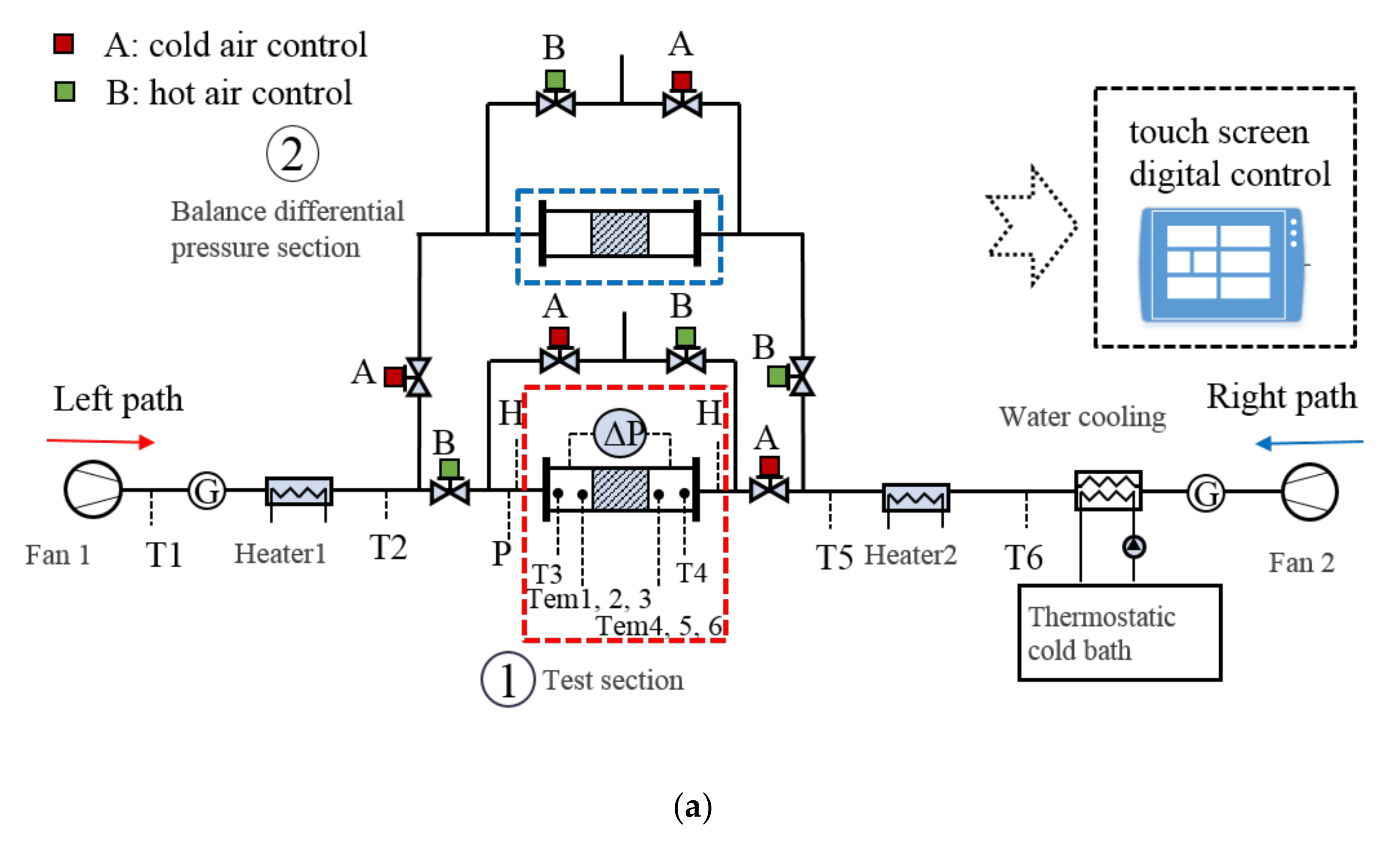
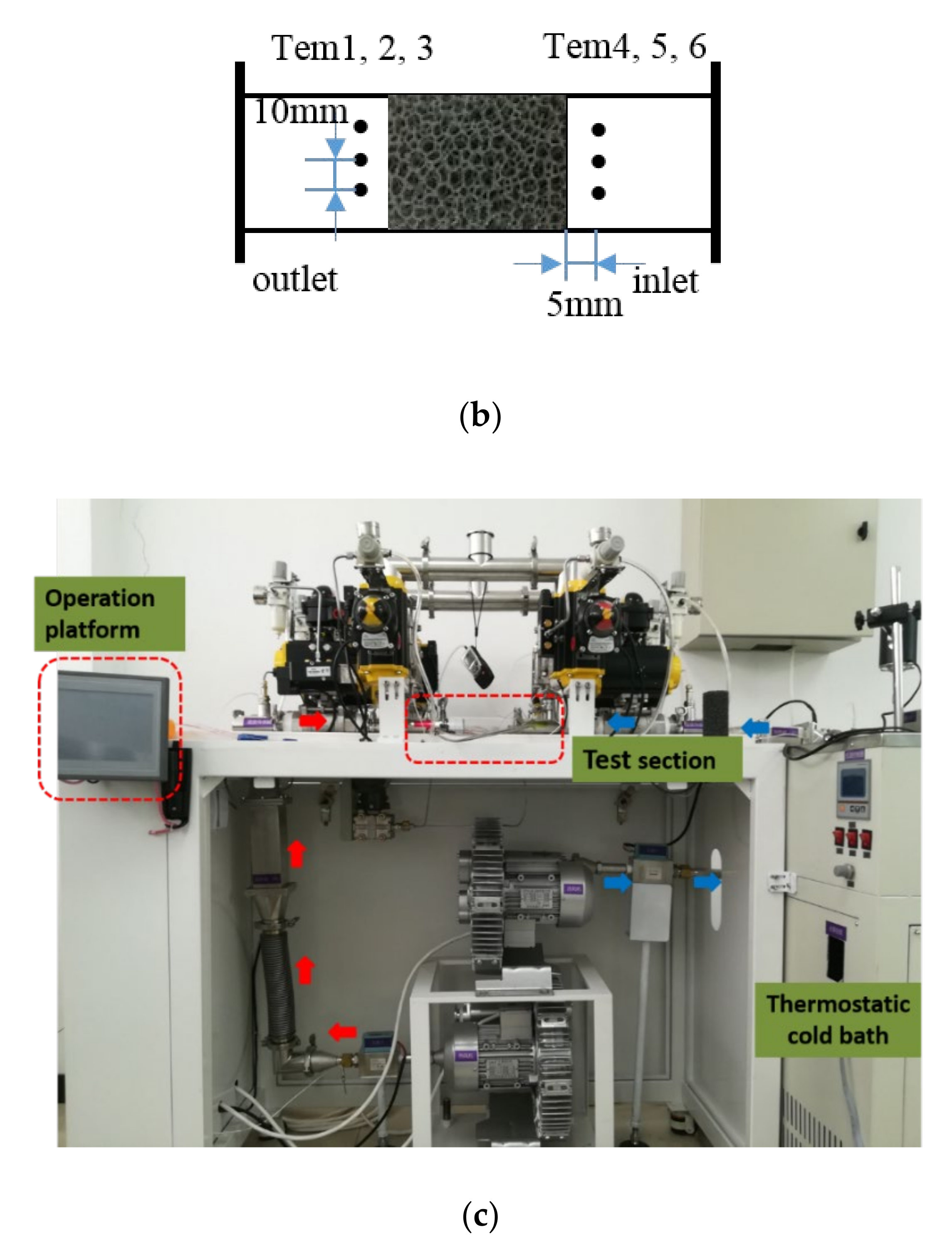



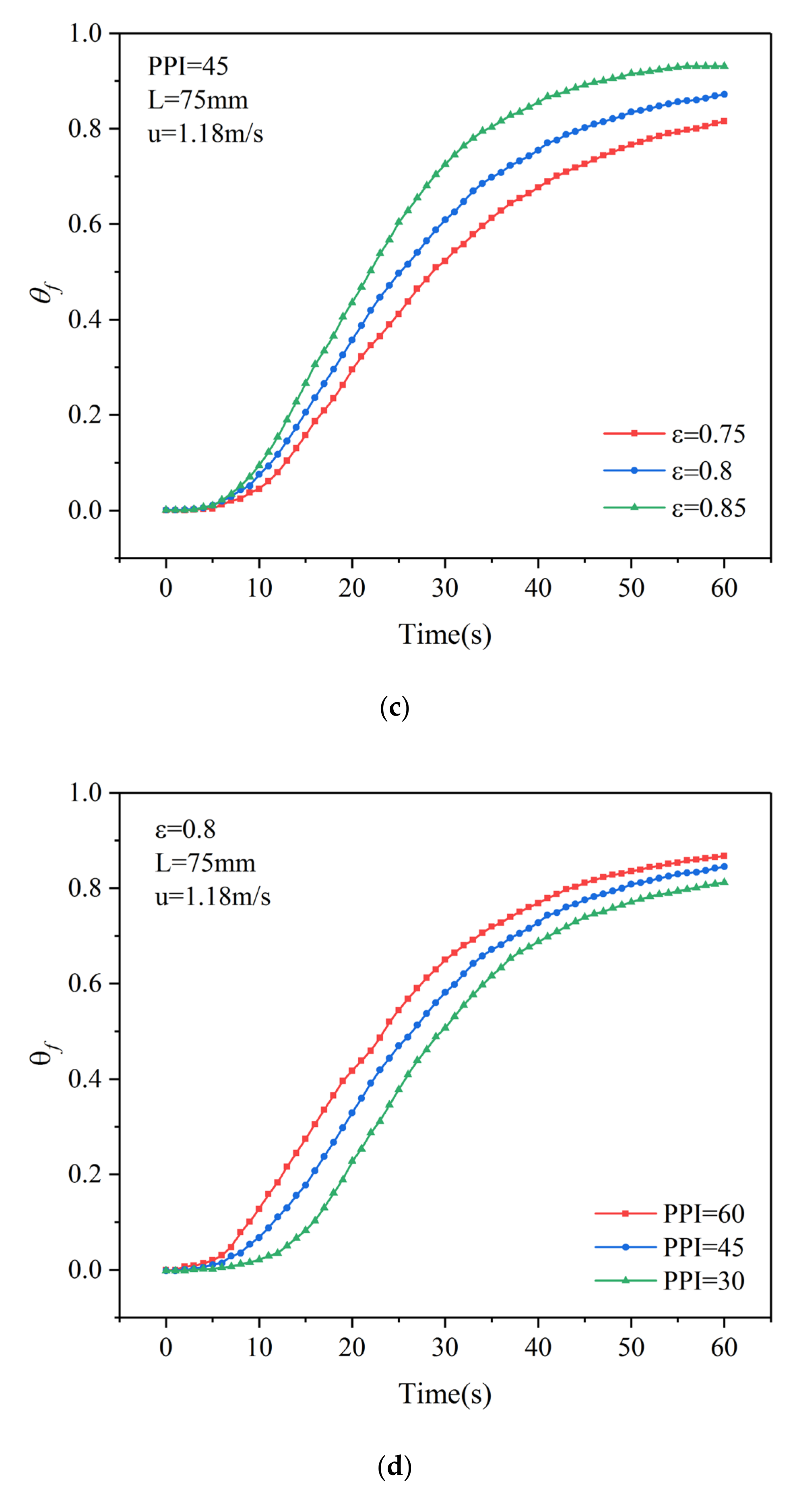
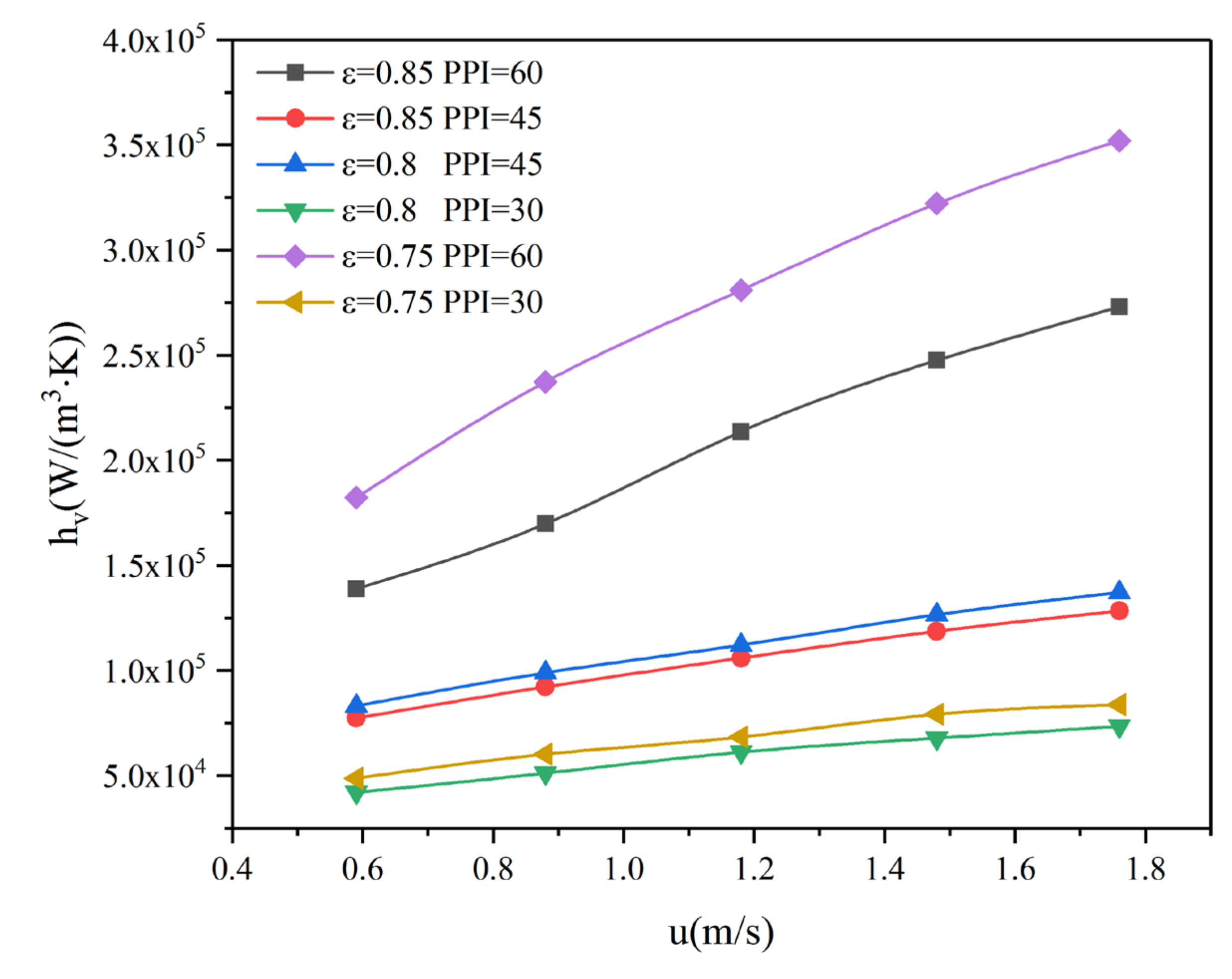


| Apparatus | Range | Uncertainty |
|---|---|---|
| T-type thermocouple | −50 to 250 °C | ±0.5 °C |
| Pt100 temperature sensor (TC Direct (UK)) | −50 to 250 °C | ±0.05 °C |
| Temperature control of heater | −40 to 180 °C | ±0.1 °C |
| Constant temperature cold bath | −30 to 80 °C | ±0.2 °C |
| Heat power (1/2) | 5000/500 W | ±1% of the reading |
| Volume mass flow meters | 50–500 L/min | ±2% of the reading |
| Absolute pressure | 0–16 Kpa | ±0.25% FS |
| Micro differential pressure transmitter | 0–10 Kpa | ±0.25% FS |
| Inverter fans | 50–500 L/min | ±1% of the reading |
| Porosity | PPI30 | PPI45 | PPI60 | Thickness | |
|---|---|---|---|---|---|
| 0.75 |  |  | 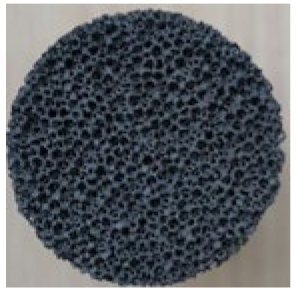 | 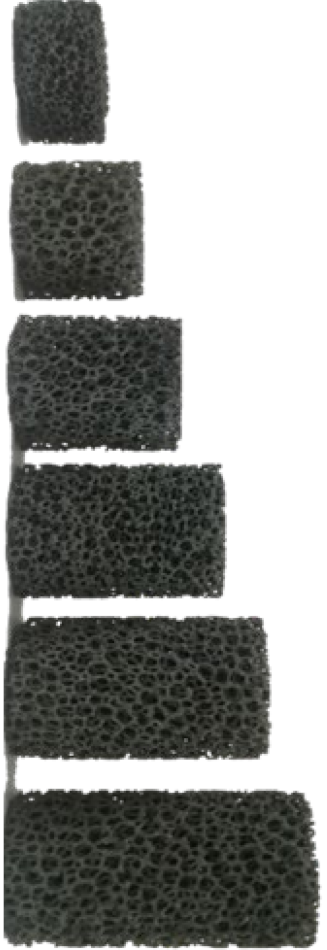 | 30 |
| 45 | |||||
| 0.8 |  |  |  | 60 | |
| 75 | |||||
| 0.85 | 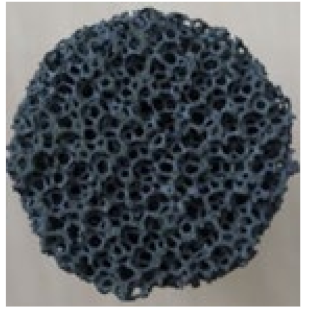 | 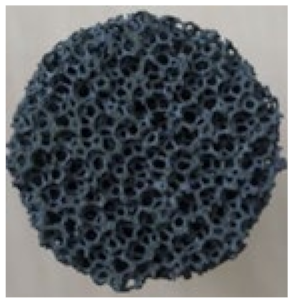 | 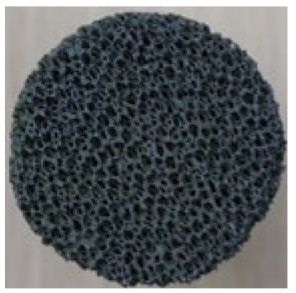 | 90 | |
| 105 | |||||
| ε | PPI | Size(mm) | dc (mm) | dp (mm) | ds (mm) |
|---|---|---|---|---|---|
| 0.75 | 60 | Φ50× (30, 45, 60, 75, 90, 105) | 2.076 | 0.835 | 0.429 |
| 45 | 4.268 | 1.482 | 0.695 | ||
| 30 | 5.605 | 0.835 | 0.982 | ||
| 0.8 | 60 | 2.142 | 0.921 | 0.367 | |
| 45 | 4.456 | 1.682 | 0.639 | ||
| 30 | 6.021 | 2.647 | 0.858 | ||
| 0.85 | 60 | 2.366 | 1.043 | 0.278 | |
| 45 | 4.617 | 1.886 | 0.566 | ||
| 30 | 6.308 | 2.991 | 0.715 |
| Density (Kg/m3) | Specific Heat [J/(Kg·K)] | Thermal Conductivity [W/(m·K)] |
|---|---|---|
| 3210 | 1244 | 80 |
| Type | Uncertainty |
| u (m/s) | 2% |
| dc (mm) | 4.3% |
| l (mm) | 0.06% |
| 2% | |
| 1% | |
| Re | 6.1% |
| 7.2% | |
| Nu | 11.3% |
Publisher’s Note: MDPI stays neutral with regard to jurisdictional claims in published maps and institutional affiliations. |
© 2020 by the authors. Licensee MDPI, Basel, Switzerland. This article is an open access article distributed under the terms and conditions of the Creative Commons Attribution (CC BY) license (http://creativecommons.org/licenses/by/4.0/).
Share and Cite
Xu, S.; Wu, Z.; Lu, H.; Yang, L. Experimental Study of the Convective Heat Transfer and Local Thermal Equilibrium in Ceramic Foam. Processes 2020, 8, 1490. https://doi.org/10.3390/pr8111490
Xu S, Wu Z, Lu H, Yang L. Experimental Study of the Convective Heat Transfer and Local Thermal Equilibrium in Ceramic Foam. Processes. 2020; 8(11):1490. https://doi.org/10.3390/pr8111490
Chicago/Turabian StyleXu, Siqi, Zhiyong Wu, Hongyan Lu, and Lixin Yang. 2020. "Experimental Study of the Convective Heat Transfer and Local Thermal Equilibrium in Ceramic Foam" Processes 8, no. 11: 1490. https://doi.org/10.3390/pr8111490
APA StyleXu, S., Wu, Z., Lu, H., & Yang, L. (2020). Experimental Study of the Convective Heat Transfer and Local Thermal Equilibrium in Ceramic Foam. Processes, 8(11), 1490. https://doi.org/10.3390/pr8111490





